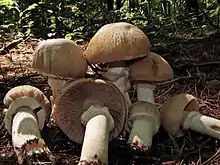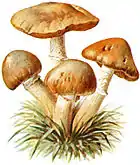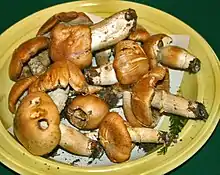Cortinarius caperatus
Cortinarius caperatus, commonly known as the gypsy mushroom, is an edible mushroom of the genus Cortinarius found in northern regions of Europe and North America. It was known as Rozites caperata for many years before genetic studies revealed that it belonged to the genus Cortinarius. The fruit bodies appear in autumn in coniferous and beech woods as well as heathlands in late summer and autumn. The ochre-coloured cap is up to 10 cm (4 in) across and has a fibrous surface. The clay-colored gills are attached to the stipe under the cap, and the stipe is whitish with a whitish ring. The flesh has a mild smell and flavor.
| Cortinarius caperatus | |
|---|---|
 | |
| Scientific classification | |
| Kingdom: | Fungi |
| Division: | Basidiomycota |
| Class: | Agaricomycetes |
| Order: | Agaricales |
| Family: | Cortinariaceae |
| Genus: | Cortinarius |
| Species: | C. caperatus |
| Binomial name | |
| Cortinarius caperatus (Pers.) Fr. (1838) | |
| Synonyms | |
|
Rozites caperata (Pers.) P. Karst. | |
| Cortinarius caperatus | |
|---|---|
float | |
| gills on hymenium | |
| cap is convex or umbonate | |
| hymenium is adnate | |
| stipe has a ring | |
| spore print is ochre to brown | |
| ecology is mycorrhizal | |
| edibility: choice | |
Popular with mushroom foragers, C. caperatus is picked seasonally in throughout Europe. Although mild-tasting and highly regarded, the mushrooms are often infested with maggots. In central Europe, old specimens could be confused with the poisonous Inocybe erubescens in summer. Fruiting bodies of C. caperatus have been found to bioaccumulate mercury and radioactive isotopes of caesium.
Taxonomy
The gypsy mushroom was originally described as Agaricus caperatus in 1796 by South African mycologist Christiaan Hendrik Persoon, who noted it grew in beech woods.[1] The specific epithet caperatus is Latin for "wrinkled".[2] Bohemian naturalist Julius Vincenz von Krombholz illustrated it in his Naturgetreue Abbildungen und Beschreibungen der essbaren, schädlichen und verdächtigen Schwämme, published between 1831 and 1846.[3] It was transferred to the genus Cortinarius by the Swedish mycologist Elias Magnus Fries in 1838.[4] Later it was transferred to Pholiota in 1874 by French mycologist Claude Casimir Gillet,[5] a placement followed by Italian naturalist Pier Andrea Saccardo.[6] Finnish mycologist Petter Adolf Karsten established the genus Rozites in 1879 to accommodate the species—as Rozites caperatus—on the basis of the mushroom having a double veil;[7] that is, a partial veil—the remnants of which become a ring on the stipe—as well as a universal veil.[8] It was known as a Rozites species for many years.[8] Meanwhile, French mycologist Lucien Quélet classified Pholiota as a subgenus of Dryophila in 1886, resulting in Dryophila caperata being added to the species' synonymy.[9] Worthington George Smith placed it in his new genus Togaria (now considered a synonym of Agrocybe).[10]
Genetic analysis in 2000 and 2002 showed that Rozites was not a discrete group and its members were nested within Cortinarius.[8][11] The gypsy mushroom was found closely related to the New Zealand species C. meleagris and C. subcastanellus, both also formerly of Rozites.[8] Hence it has once more been placed within Cortinarius.[12] Within the genus it is classified in the subgenus Cortinarius.[13]
Common names include the gypsy mushroom,[14] gypsy,[13] and wrinkled rozites.[15] An unusual common name is granny's nightcap in Finland.[2]
Description

C. caperatus has a buff to brownish-ochre cap 5–10 cm (2–4 in) diameter, which is covered with whitish fibres. The surface has a wrinkled and furrowed texture.[15] It may have a lilac tinge when young. It is convex initially before expanding and flattening with a boss (umbo) in the centre. The stipe is 4–7 cm (1.6–2.6 in) high and 1–1.5 cm (0.4–0.6 in) thick and slightly swollen at the base, and is whitish with a whitish ring, which is initially attached to the cap.[16] Also known as a partial veil, this is a key identifying feature of the mushroom.[17] The clay-coloured gills are free—they do not reach the stipe under the cap. The spores give an ochre-brown spore print, and the warty almond-shaped spores measure 10–13 µm long by 8–9 µm wide. The flesh is cream-coloured and the flavor mild.[16]
Similar-looking North American species include Agrocybe praecox, which lacks the wrinkled cap and is found in cultivated areas, and Phaeolepiota aurea, which has powdery-granular surface.[14] In central Europe, old specimens could be mistaken for the highly poisonous Inocybe erubescens in summer, and young mushrooms for the inedible Cortinarius traganus, although the latter is readily distinguished by its unpleasant odour.[18]
Distribution and habitat
C. caperatus is found across northern Europe, mainly in Scandinavia, where it is common, although it is uncommon in Denmark and Iceland.[19] In the British Isles it is uncommon outside the Scottish Highlands[2] and the New Forest.[20] It has been classified as vulnerable in Germany and Great Britain and endangered in the Netherlands.[21] C. caperatus had become less common in the vicinity of Salzburg in Austria between 1937 and 1988, thought due to picking.[22]
It is widely found in northern parts of North America,[14] as far south as Mendocino County on the west coast. It is uncommon in California.[23] C. caperatus is a rare component of subarctic areas of western Greenland.[24] The gypsy mushroom also grows in temperate Asia, having been recorded growing with bilberry near oriental beech (Fagus orientalis) and fir near Pamukova in the Marmara Region of Turkey.[25] It is also found in boggy areas of the taiga (boreal pine forest) in western Siberia.[26]
Fruiting bodies sprout from August to October in conifer and beech woods, as well as heather (often close by sphagnum) in Scotland. It is mycorrhizal but non-selective in its hosts.[2] Mushrooms appear from September to November in North America,[27] and July and August in Alaska.[28] It prefers acidic and sandy soils and avoids chalky ones,[29] and may be found in the same habitats as bay bolete (Imleria badia), brown rollrim (Paxillus involutus), and chanterelles.[30] It forms relationships with Scots pine (Pinus sylvestris).[31] It is often found under Sitka spruce (Picea sitchensis),[23] or near huckleberry in North America.[14] In Alaska it grows with dwarf birch (Betula nana) and American dwarf birch (B. glandulosa).[28] In Greenland, it grows in association with white birch (Betula pubescens).[24]
Edibility

C. caperatus is a highly regarded edible mushroom with a mild flavour. It is said to mix well with stronger-flavoured fungi such as chanterelles, boletes, brittlegills or milk-caps.[2] The mushroom can have a faintly bitter taste if eaten raw, but a pleasant nutty flavour when cooked.[28] It can readily be dried for later use, such as adding to soups and stews.[15] It is sold commercially in Finland,[32] and is a popular target of foragers in many parts of Europe.[33] The mushrooms are often found to be infested with maggots when picked.[30] Mycologist David Arora recommends discarding the tough stipes.[14]
Radioactivity and environmental contamination
The popularity of C. caperatus across Europe has led to safety concerns related to its propensity to accumulate contaminants.[34] Fungi are very efficient at absorbing radioactive isotopes of caesium from the soil and naturally have trace amounts of the element. Caesium may take the place of potassium, which exists in high concentrations in mushrooms.[33] C. caperatus bioaccumulates radioactive caesium 137Cs—a product of nuclear testing—much more than many other mushroom species. Levels dramatically rose after the 1986 Chernobyl disaster. This is a potential health issue as picking and eating wild mushrooms is a popular pastime in central and eastern Europe. Elevated 137Cs levels were also found in ruminants that eat mushrooms in Scandinavia in the 1990s.[35] Mushrooms from Reggio Emilia in Italy were found to have raised levels of 134Cs.[33] C. caperatus from various sites across Poland has also been found to contain increased levels of mercury.[34]
See also
References
- Persoon CH (1796). Observationes mycologicae. 1. Apud Petrum Phillippum Wolf. pp. 48–49.
- Nilson S, Persson O (1977). Fungi of Northern Europe 1: Larger Fungi (Excluding Gill-Fungi). Penguin. p. 86. ISBN 978-0-14-063005-3.
- von Krombholz JV (1831–1846). Naturgetreue Abbildungen und Beschreibungen der essbaren, schädlichen und verdächtigen Schwämme (in German). Plates. In Commission in der J.G. Calve'schen Buchhandlung. plate 73 (10–12).
- Fries EM (1838). Epicrisis Systematis Mycologici: Seu Synopsis Hymenomycetum [A Critical Study of Mycology: A Synopsis of the Hymenomycetes] (in Latin). 1–2. Regiae Academiae Typographia. p. 256.
- Gillet CG (1874). Les Hyménomycètes, ou, Description de tous les champignons (fungi) : qui croissent en France, avec l'indication de leurs propriétés utiles ou vénéneuses. 3. Ch. Thomas. p. Plate 517.
- Saccardo PA (1887). Sylloge fungorum omnium hucusque cognitorum. 5. Patavii (Padua): sumptibus auctoris. pp. 736–37.
- Karsten PA (1879). "Rozites caperatus". Bidrag till Kännedom av Finlands Natur och Folk / Utgivna av Finska Vetenskaps-Societeten (in Swedish). 32: 290.
- Peintner U, Horak E, Moser M, Vilgalys R (2002). "Phylogeny of Rozites, Cuphocybe and Rapacea inferred from ITS and LSU rDNA sequences". Mycologia. 94 (4): 620–29. doi:10.2307/3761713. JSTOR 3761713. PMID 21156535.
- Quélet L. (1886). Enchiridion Fungorum in Europa media et praesertim in Gallia Vigentium (in Latin). Octave Dion. p. 66.
- Smith WG (1908). Synopsis of the British Basidiomycetes ; a descriptive catalogue of the drawings and specimens in the Department of botany, British museum. Printed by order of the Trustees of the British museum. p. 121.
- Høiland K, Holst-Jensen A (2000). "Cortinarius Phylogeny and Possible Taxonomic Implications of ITS rDNA Sequences". Mycologia. 92 (4): 694–710. doi:10.2307/3761427. JSTOR 3761427.
- Peintner U, Horak E, Moser M, Vilgalys R (2002). "Rozites, Cuphocybe and Rapacea are taxonomic synonyms of Cortinarius: New combinations and new names". Mycotaxon. 83: 447–51.
- Buczacki S, Shields C, Ovenden D (2012). Collins Fungi Guide. Collins. p. 322. ISBN 978-0-00-746648-1.
- Arora D (1986). Mushrooms Demystified: a Comprehensive Guide to the Fleshy Fungi (2nd ed.). Ten Speed Press. p. 412. ISBN 978-0-89815-169-5.
- Lamaison J-L, Polese J-M (2005). The Great Encyclopedia of Mushrooms. Könemann. p. 138. ISBN 978-3-8331-1239-3.
- Phillips R (2006). Mushrooms. Pan MacMillan. p. 207. ISBN 978-0-330-44237-4.
- Courtecuisse R. (1999). Mushrooms of Britain and Europe. Collins Wildlife Trust guides. Harpercollins. pp. 456–57. ISBN 978-0-00-220012-7.
- Zeitlmayr L. (1976). Wild Mushrooms:An Illustrated Handbook. Garden City Press. p. 79. ISBN 978-0-584-10324-3.
- Gry J, Andersson C (2014). "Cortinarius caperatus (Pers.) Fr. (Rozites caperatus (Pers.) P. Karst.)". Mushrooms traded as food. Vol II sec 2: Nordic risk assessments and background on edible mushrooms, suitable for commercial marketing and background lists for industry, trade and food inspection. Risk assessments of mushrooms on the four guidance lists. Nordic Council of Ministers. pp. 164–5. ISBN 978-92-893-2705-3.
- Fungal Records Database for the British Isles "Archived copy". British Mycological Society. Archived from the original on 23 July 2011. Retrieved 16 January 2010.CS1 maint: archived copy as title (link)
- Arnolds E (1995). "Conservation and management of natural populations of edible fungi". Canadian Journal of Botany. 73 (S1): 987–98. doi:10.1139/b95-349.
- Rücker T, Peer T (1988). "Pilzsoziologische Untersuchungen am Stubnerkogel (Gasteiner Tal, Salzburg, Osterreich) unter Berücksichtigung der Schwermetallsituation". Nova Hedwigia (in German). 47: 1–38.
- Siegel N, Schwarz C (2016). Mushrooms of the Redwood Coast: A Comprehensive Guide to the Fungi. Potter/TenSpeed/Harmony. p. 202. ISBN 978-1-60774-818-2.
- Elborne SA, Knudsen H (1990). "Larger Fungi Associated with Betula pubescens in Greenland". In Fredskild B, Ødum S (eds.). The Greenland Mountain Birch Zone, Southwest Greenland. Museum Tusculanum Press. pp. 77–80. ISBN 978-87-635-1204-6.
- Akata I, Kabaktepe Ş, Akgül H (2015). "Cortinarius caperatus (Pers.) Fr., A New Record For Turkish Mycobiota". Kastamonu University Journal of Forestry Faculty. 15 (1): 86–89. doi:10.17475/kuofd.94670.
- Filippova NV, Thormann MN (2014). "Communities of larger fungi of ombrotrophic bogs in West Siberia" (PDF). Mires and Peat. 14: 1–22.
- Baroni TJ. (2017). Mushrooms of the Northeastern United States and Eastern Canada. Timber Press Field Guide. Timber Press. p. 308. ISBN 978-1-60469-814-5.
- Laursen GA, McArthur N (2016) [1994]. Alaska's Mushrooms: A Wide-Ranging Guide. Graphic Arts Books. p. 71. ISBN 9781943328765.
- Pegler D (1983). Mushrooms and Toadstools. Littlehampton Book Services Ltd. p. 34. ISBN 978-0-85533-500-7.
- Haas H (1969). The Young Specialist Looks at Fungi. Burke. p. 124. ISBN 978-0-222-79414-7.
- Trappe JM (1962). "Fungus Associates of Ectotrophic Mycorrhizae". The Botanical Review. 28 (4): 538–606. doi:10.1007/bf02868758. JSTOR 4353659. S2CID 42698903.
- Pelkonen R, Alfthan G, Järvinen O (2008). Element Concentrations in Wild Edible Mushrooms in Finland (PDF). Finnish Environment Institute. p. 32. ISBN 978-952-11-3153-0.
- Zalewska T, Cocchi L, Falandysz J (2016). "Radiocaesium in Cortinarius spp. mushrooms in the regions of the Reggio Emilia in Italy and Pomerania in Poland". Environmental Science and Pollution Research International. 23 (22): 23169–74. doi:10.1007/s11356-016-7541-0. PMC 5101288. PMID 27600726.
- Falandysz J (2014). "Distribution of mercury in Gypsy Cortinarius caperatus mushrooms from several populations: An efficient accumulator species and estimated intake of element". Ecotoxicology and Environmental Safety. 110: 68–72. doi:10.1016/j.ecoenv.2014.08.018. PMID 25199584.
- Kalač P (2001). "A review of edible mushroom radioactivity" (PDF). Food Chemistry. 75: 29–35. doi:10.1016/s0308-8146(01)00171-6.
External links
 Media related to Cortinarius caperatus at Wikimedia Commons
Media related to Cortinarius caperatus at Wikimedia Commons